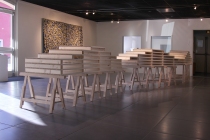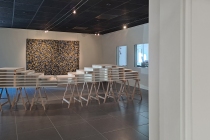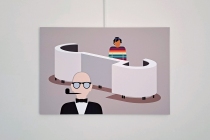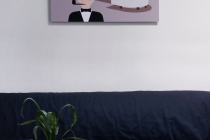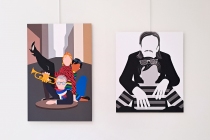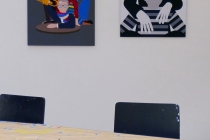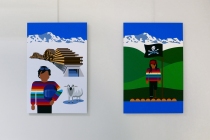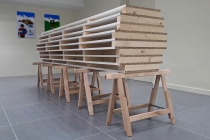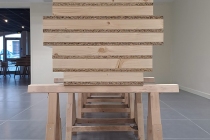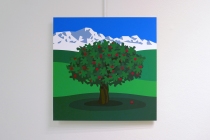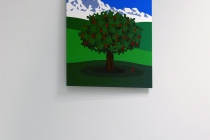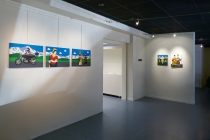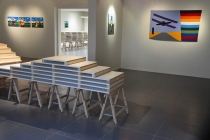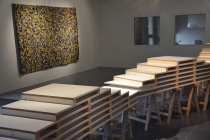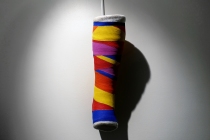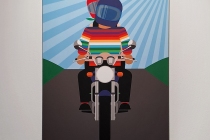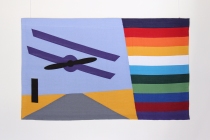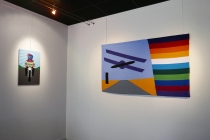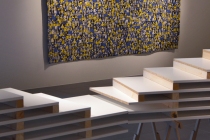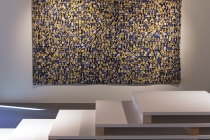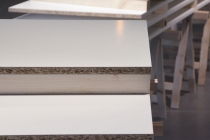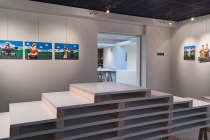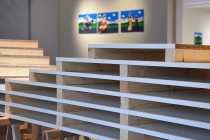Solo exhibition.
La Maison des Arts, Aime-La-Plagne. 24th June – 5th August 2022.
THE OTHER SIDE OF THE MOUNTAIN is the title of a nursery rhyme. It is the story of a curious bear who sets out to climb a mountain to see all that there is to see. At the end of the song, the only thing that the bear discovers is the other side of the mountain. The children of course receive this song in all innocence, but there lies a humanist (even political) undercurrent, as mountains and rivers are often used as borders. In the end, the little bear, the hero of this story, discovers that everything is the same, that there is no fundamental difference…
The bear went over the mountain (repeat x3)
To see what he could see (repeat x3)
The bear went over the mountain (repeat x3)
To see what he could see
The other side of the mountain (repeat x3)
Was all that he could see (repeat x3)
The other side of the mountain (repeat x3)
Was all that he could see
David Michael Clarke was born and grew up on the south coast of England. When he was old enough to leave his parents home, he went to study at the Glasgow School of Art in Scotland. For the most part, it was a happy and productive time, but when he reached the age of thirty, his feet started itching again and he sensed that he had to set off once more in the search of something new … and so it was that in 1999, DMC (as he is often called) arrived in France with the same sense of curiosity as the bear.
« Curiosity is one of the most essential qualities for an artist. Without it, art wouldn’t exist. Curiosity is the motivation that drives us to go and look at something more closely. It leads us to observation, to the act of seeing. As an artist, before we start doing anything, we look at the world around us, and in so doing establish a point of view. »
Even though DMC states that he saw no fundamental difference, that there is good and bad everywhere, that people are basically the same, he did discover a plethora of cultural differences that had been built over time and manifest themselves today through language, literature, art and music.
DMC is a complex artist. He clearly has an interest in modern architecture and design. He says that he inherited this from his first art teacher, who told him about Le Corbusier. Later at art school he learnt about Fluxus and gradually became interested in performance and collective practices. On the one hand he defends a conceptual approach, meaning that he is for an art that questions art itself. On the other hand he will deny being a purist, saying that he is just as interested in other people and life in itself. DMC believes this central paradox to be fertile ground for making art, noting that it was first identified by Robert Filliou when he said,
« Art is what makes life more interesting than art. »
More recently we have seen other aspects emerge in DMC’s work, notably music, songs that he writes with his students or other artists that he meets as he travels, and drawings made on a computer using vector-graphic software.
In 2019, DMC was invited by the Foundation Facim to conceive B-ROADS, a smartphone application having the aim to introduce the baroque art of the Savoie region to a younger audience. To research his subject he rode through the towns and villages of the Tarentaise valley on his motorbike and learnt about life in the Alps and the patron saints that have been evoked to protect the local people over the centuries. Many of the sculptures that can be (re)found in the churches of Aime, La Côte d’Aime Valezan, Macot and Landry have been included in this geo-localized application.
The images might have remained virtual, forever destined for the pocket screen. However for DMC, this exhibition seemed to be the fortuitous moment to print some of the images to see how they worked on a larger scale. Also if in designing application B-ROADS, DMC stuck to the baroque theme, he also wanted to seize the moment to break out of the constraints of the commande and mix up baroque iconography with images that come from other sides of life.
« I suppose I somewhat owe this approach to the artists of Pop Art, or New Realism as it is known in France. In the 1960’s, they really broke down cultural hierarchy. Today, artists don’t hesitate to try out new recipes. Lofty ideas are translated via commercial techniques. Throw-away ideas are meticulously laboured over by craftspeople. »
Thus as an exhibition, THE OTHER SIDE OF THE MOUNTAIN, can be seen as a sort of surreal dreamscape, where the baroque meets Brexit, pirates mingle with the pious, and Hitchcock revisits Helvetica.
Text : Marie-Laure Bazzani & David Michael Clarke.

